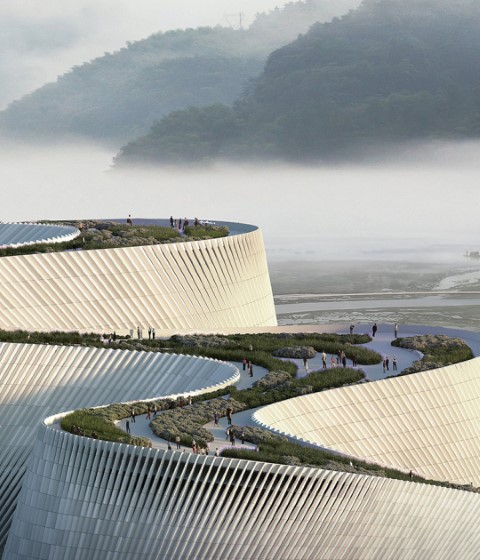For the student and faculty housing, Dominique Perrault Architecture and Zhubo Design Co were inspired by the traditional Chinese composition of housing, proposing villages with terraced architecture with courtyards set into the topography.
In terms of materiality, "Horizon" is wrapped in large windows framed by fine metallic lines, which provide natural light to all its spaces, while ensuring views of the landscape and interacting with the exterior through reflections of the sun's rays.
Description of project by Dominique Perrault Architecture and Zhubo Design Co.
In recent years, the city of Shenzhen has launched numerous international competitions for the creation of large-scale cultural and sports facilities, attracting architects from around the world.
In particular, the city is planning the construction of a dozen cultural facilities that will assert the city as an internationally recognized innovation center. Alongside the new campus of the Shenzhen Institute of Design and Innovation, there is an impressive list of new projects: the Shenzhen Opera House, the Shenzhen Exhibition Center, the Design Museum, the Shenzhen National Museum, the Museum of Science and Technology, the Oceanographic Museum, the Nature Museum, the Shenzhen Museum of Art and the Shenzhen Music Conservatory.
The new campus of the Shenzhen Institute of Design and Innovation will form one of the new sites of the Southern University of Science and Technology (SUSTech), which was established in 2011, and will accommodate about 4,000 students. This project demonstrates the city’s ambition to create a high-level international school in response to an increasing demand for talents in the field of design, in Shenzhen and the Guangdong-Hong Kong-Macao bay. Among 37 successful teams selected through the open application process, nine were shortlisted to participate in the design competition, including renowned offices such as MVRDV and Studio Libeskind.
«HORIZON»
The site chosen for the new campus is located on the outskirts of Shenzhen, in a still mainly rural area, along with the mountain relief of the «Phoenix Mountain.» The project is integrated into the landscape, and preserves the legibility of its horizontal structure, ensuring that no prominent architectural element would disturb this «plateau» geography. Inspired by the Chinese character «--», reflecting the atmosphere of a line of mountain and water, it creates a large-scale landmark, a horizontal line in the site, detached from the ground like a large bridge, and develops a built front of more than 700 meters long. Hung above the ground, the main volume maintains visual transparency at pedestrian level, and its compact height guarantees views towards the great landscape. Above the natural ground, it creates a protective shelter, hosting public spaces and gardens, punctuated by «domes» housing various easily identifiable academic functions. The functional organization of the campus is simple and intuitive, articulated around two main elements: the «Hyper-Ground» and the «Hyper-Roof».
HYPER-GROUND
The project encourages pedestrians and soft circulations, limiting road traffic on the entire site. Underneath the entire length of the suspended volume is located the main circulation axis of the campus: a long-protected pedestrian promenade, designed as a wide platform on which the functional activities of the campus, various public spaces, and access to the common programs are developed. The main public space is shaped by a large outside square, hosting the social life of the campus. On the city side, a mineral amphitheater connects the university site to its neighborhood and forms the entrance to the campus. The project underlines a strong desire to create exchanges and interactions, to hybridize disciplines in order to encourage innovation and excellence. The approach also seeks to introduce a strong vegetation and the creation of intimate and protected spaces, through porosity between interior and exterior. Along the shaded and airy pedestrian avenue, large circulation cores are arranged to connect the ground and roof levels, as well as the functions between them. The common facilities are located in the monumental «domes» visible from the «hyper-ground»: the library, the university refectory, the auditorium, the exhibition halls, and the student club, a common space for gathering and relaxation.
HYPER-ROOF
The circulation cores that connect the «Hyper-roof» to the «Hyperground» serve all the teaching spaces located on the two levels of the main volume: classrooms, teaching laboratories, and research laboratories. Above, the roof creates a panoramic promenade, a huge balcony overlooking the city, 50m above street level. The access to the roof level offers a real garden for everyone, arranged in different sectors, each with a specific program and atmosphere: garden spaces, terraces, plazas, sports areas, etc. Treated with the same attention as the project’s vertical façades, the large roof also plays an active role in the technical functioning of the campus. The roof is widely vegetated and contributes to the insulation of the building and the recovery of rainwater. The installation of photovoltaic panels also provides energy for the entire building.
PATIO-VILLAGES
The student's and professor's housing consists of several «villages», offering a terraced architecture with patios. These groups of housing units set in the topography, with their green roofs, are reminiscent of the traditional layout of the hillside terraces, and their patios are a reference to the traditional Chinese composition of housing.
MATERIALS
The preferred materials are metal and glass. Punctuated by thin vertical lines of light metal, the large windows provide natural lighting for all the working spaces and wide views of the landscape. The vibrations of the envelope, between the white and emerald tones of glass metal, will constantly vary its appearance so that the building will be perceived differently depending on the angles of approach, the seasons, or the time of day. The reflections unify the composition and preserve the interior activity from outside views. Finally, the constructive principles and the arrangement of the spaces allow great flexibility in the interior design and the possibility of imagining possible future developments of the campus.































